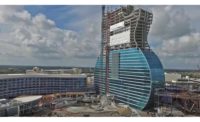Much like an NFL franchise, the construction team on the $1.5-billion Seminole Hard Rock Hotel & Casino project has its sights set on the Super Bowl. Plans to expand and renovate the casino complex on 100 acres in Hollywood, Fla., began more than a decade ago. But when the NFL announced in 2016 that nearby Miami would host Super Bowl LIV in 2020, the project gained a sense of urgency.
Leaders of the Seminole Tribe of Florida and Seminole Gaming tasked the team with finalizing designs and completing construction of the 3.2-million-sq-ft, master-planned project in less than four years, including a broad mix of vertical buildings and infrastructure. After more than a year of preconstruction, vertical work began in October 2017, with a target opening by game day in February 2020.
The project’s signature feature is a 596,044-sq-ft hotel tower shaped like the body of a guitar. It will be 450 ft tall, or approximately the length of 153 guitars. In addition, the plan calls for a separate eight-story hotel tower, expansion of meeting rooms, improvements on two garages, pools, villas, a central energy plant and the remodel and expansion of buildings that house gaming and restaurant spaces (ENR 3/4-11 p. SE34).
Adding to the challenge, the owner put an emphasis on keeping facilities operational—particularly the gaming tables and slots—during construction.
Package Deal
Seeking more efficiency, the construction manager—a joint venture of Suffolk Construction and Yates Construction—broke the project into smaller components. Numerous factors were considered during preconstruction for how best to create the parcels, says Peter Tuffo, president and general manager of Suffolk Construction’s southeast division.
On an entertainment campus built around games of chance, the lucky number of individual components turned out to be 13. One major consideration was how to reasonably subcontract the work and find enough labor in the saturated Miami construction market. “We felt that [breaking up the project] was the best way to maximize participation from local trade partners,” Tuffo says. “It also allowed us the opportunity to ensure we could have 2,400 tradesmen per day at peak.”
“That many people … it’s basically a division in and of itself.”
– Peter Tuffo, Suffolk Construction
The multiple components also mitigated potential risks of having overly large specialty contracts. Kyle Goebel, senior project manager at Suffolk-Yates, says work could be released early where design was further along, such as the central energy plant and meeting rooms at the convention center. “Across the spectrum, there was almost every level of development,” he says.
The guitar-shaped hotel, for example, reached the construction docs phase early on, but the neighboring pool complex—with 10 acres of pools, lagoons and cabanas—was still early in design development. Even before its CM contract was awarded, Goebel says the team committed to extensive use of BIM during preconstruction, including converting 2D drawings from Klai Juba Wald Architects to 3D.
“A big selling point of the [virtual design and construction] process is our ability to assist in design completion,” he adds. “During precon, we already had multiple components of the project built in 3D, which provided a lot of value not only to our team, but to the tribe as well. We could help develop the design and also the phasing of the construction.”
Early development of a federated BIM model also allowed use of design-assist with key trade partners to establish the budget and any allowances that needed to be in place for less-defined work, in keeping with the guaranteed maximum price. “That allowed us to make sure we met the owner’s expectations for the final product while maintaining budget,” Tuffo says.
Trades On Board Early
Jessica Chen, project executive with Suffolk-Yates, says the team needed to get to a guaranteed maximum price (GMP) early on, which meant hiring trade partners as soon as possible. “As a company, we won’t sign a GMP until we’ve reached at least 80% commitment dollar-wise with our trade partners,” she says.
While breaking the project up into smaller packages helped the team gain a more detailed understanding of each area, it was harder to manage 13 components that often intersect and potentially conflict. Suffolk-Yates has 103 management and support people on the project, more than 80% of them on staff before the project began, so the team largely avoided competing for talent in the Miami market. “That many people … it’s basically a division in and of itself,” Tuffo says.
Each component has its own dedicated lead project managers and superintendents, who report to four project executives. Those executives oversee projects based on their areas of expertise. Chen, for example, has a background in high-rise construction, so her projects include both the guitar tower and the neighboring pool tower. Others with experience in casino gaming projects oversee those elements.
Another consideration was how best to align each component with the owner’s management structure. Chen notes that within Hard Rock International, groups manage different parts of the business, such as restaurants, retail, hospitality and gaming. “We were able to reduce necessary points of contact, which works to the owner’s benefit,” she says. “It not only makes it more personable for the owners, it also means they can feel more comfortable working with a team of four or five, rather than more than 100 [Suffolk-Yates] people.”
A high level of communication with the owner is required as designs continue to develop. Those decisions range from fit-outs and finishes to complete structures. For example, during construction, the owner decided to change a planned remodel of the Hard Rock Live venue to an entirely new facility.
“The owner made the decision to demo the existing 5,500-seat Hard Rock Live and go back up with a 6,500-seat venue, which was sandwiched between the existing casino and a new addition,” Tuffo says. “At that point, we had already started the addition.”
Throughout the process, Goebel says the team has heavily leveraged the 4D (schedule) and 5D (budget) aspects of BIM. As ideas are exchanged between owner and the design team, Suffolk-Yates uses the model to illustrate how decisions affect schedule and budget.
“It’s a continuous model of as-built conditions,” Goebel says. “Normally, you wouldn’t have this level of detail until the end. We’ve had to model everything from light-pole foundations to tree-root structures.”
Goebel says all temporary work has to be modeled to show how it could affect casino operations. “A handful of times, [the owner] said that a specific machine was someone’s favorite slot, so we had to move it somewhere else, so [the customer] would have a place to play,” he says. “That’s the level of coordination we get into.”
Goebel says that keeping the labor force safe and happy is equally important to keeping the client happy. The team created a dedicated break area on site with food trucks, TVs, fans, air-conditioned bathrooms, phone-charging stations and other amenities.
“That’s part of being in a saturated market,” he adds. “If we want to maintain workforce, we need to create a better work experience.”







